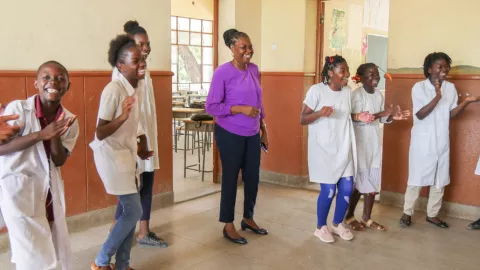Assistive Technology in Humanitarian Settings
For children with disabilities

Highlights
There are 240 million children with disabilities in the world; half of them are out of school. Many are invisible, stigmatized, hidden by their families and abandoned by their governments. Children with disabilities, especially in humanitarian settings, are among the poorest members of the population and one of the most marginalized and excluded groups in society.
With only an estimated 1 in 10 children with a need for assistive devices having access, UNICEF’s Office of Research – Innocenti undertook a study to better understand the nature and drivers of Assistive Technology (AT) access in humanitarian settings.
The Overview of research document provides a synthesis of the project’s various reports and papers: (1) a thematic literature review summarizes the academic evidence base regarding the provision of AT in humanitarian settings, including the nature and scale of provision and barriers and facilitators of access and provision; and (2) three case studies of countries affected by crisis to triangulate the findings of the literature review and fill identified knowledge gaps with real-world examples: Afghanistan, South Sudan, and the State of Palestine.
The Literature review discusses the barriers to assistive technologies provision in humanitarian settings and considers possible entry points for provision in the future. Recommendations include: coordination platforms for provision; gathering evidence on existing in-country provision and strengthening those systems; designing programmes for provision that account for pre-existing barriers, within-crises barriers including those internal to humanitarian organizations like UNICEF.
Afghanistan case study: Due to the impacts of the ongoing conflict, Afghanistan’s child population is at high risk of being born with or acquiring a primary or secondary disability. According to a recent estimate, up to 17 per cent of Afghanistan’s children live with some form of disability. Assistive technologies – the systems, services and products that enhance the functioning of people with impairments – are likely to be required by a large proportion of children with disabilities in Afghanistan. Afghanistan has signed and ratified the United Nations Convention on the Rights of Persons with Disabilities, which includes a commitment to provide assistive technologies equitably to all who need it. However, little action has been taken to meet this commitment, and there continues to be a vast gap between need and provision. This work presents the the barriers and facilitators to provision and provides recommendations to begin to close the gap.
South Sudan case study: South Sudan is in a protracted crisis. Four million people have been displaced and many have been left living with high levels of injury, poverty and food insecurity. The impact of the crisis on children – who make up over 29 per cent of the population – is particularly high, and a large number are at risk of being born with or acquiring a disability. Assistive technologies (AT) – the systems, services and products that enhance the functioning of people with impairments – are likely to be required by many children in South Sudan with disabilities. There is no reliable data available on disability prevalence or AT needs in South Sudan, though estimates suggest a range between 10 per cent and 15 per cent of the population. This work aims to understand the landscape of AT provision and the barriers and facilitators to provision and provides recommendations for priority actions.
State of Palestine case study: Official statistics identify 2 per cent to 7 per cent of the population in the State of Palestine as having a disability. Evidence is limited regarding levels of access to assistive technologies (AT) by people with disabilities in the State of Palestine. However, estimates suggest that there are high levels of unmet need. Less than 10 per cent of children with disabilities received assistive devices in the year of one recent survey. The COVID-19 pandemic has had an impact on a range of such services in many countries, but little information is yet available on the impact on AT provision in humanitarian settings.





